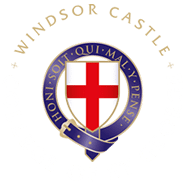The wedding of Prince Henry of Wales with Ms Meghan Markle will be celebrated this Saturday, 19 May, in St George’s Chapel. The first Royal wedding known to have taken place in St George’s is that of Queen Victoria’s eldest son: Albert Edward, Prince of Wales, who married Princess Alexandra of Denmark in a lavish ceremony on 10 March 1863 (they later became King Edward VII and Queen Alexandra). Many of their siblings, cousins and descendants later chose St George’s as a wedding venue and Prince Harry now becomes the second of their great-great-great grandsons to do so, after Peter Philips married Autumn Kelly in the Chapel in 2008.
Historically, Royal marriages at Windsor were by no means common. The oldest surviving register of marriages in St George’s Chapel (SGC R.1) dates back to 1627 and it records none before 1863. Earlier records have not survived, making it difficult to trace any ceremonies that might have taken place at St George’s in the three centuries between its foundation and the surviving register.
However, one early Royal marriage is known to have been celebrated at Windsor Castle at least: that of Edward, Prince of Wales, and Joan, Countess of Kent, in 1361. Edward, remembered as the Black Prince for the armour he wore at the Battle of Crécy, was the eldest son of King Edward III, who founded St George’s Chapel and established the Order of the Garter in the late 1340s.
The match was a controversial one, for not only had Joan been married before, but twice and at the same time! In 1340 Joan, who as a granddaughter of King Edward I should have had any marriage approved by the monarch, had secretly married English nobleman and military commander Thomas Holland. A year later, while Holland was in France on campaign, Joan’s family arranged for her to be married to William de Montagu, the eldest son of the Earl of Salisbury. Fearing the consequences if her secret marriage was discovered, Joan – then only thirteen years old – married Montagu without revealing her earlier marriage to Holland. In fact, it was not discovered until Holland returned from France in 1348. After an appeal to the Pope, it was determined that the second marriage should be annulled and Joan remained married to Holland until his death in 1360.
Coincidentally, Holland and Montagu were both Founder Knights of the Order of the Garter and a stall plate bearing Montagu’s coat of arms still survives in the quire stalls of St George’s Chapel.
The Countess of Kent’s unusual history made her an unlikely candidate for the bride of the heir to the medieval English throne; his father had been making plans for a politically advantageous match for him. So when Joan and Edward married in the summer of 1361, only a few months after her first husband’s death and with her second husband still living, it was another secret marriage. Later that year they sought Royal permission from King Edward III and dispensation from the Pope, because they were first cousins once removed and Edward was Godfather to Joan’s eldest son by Holland.
Permission being granted, they contracted their marriage officially in the presence of the Archbishop of Canterbury and celebrated it publicly at Windsor Castle on 10 October 1361. No explicit mention is made of any visit to Edward III’s recent foundation, St George’s Chapel, as part of the festivities. However, one of the earliest inventories of the Chapel, compiled in 1384, lists among its belongings “one red vestment of cloth-of-gold powdered with various birds, in which the lady Princess was espoused.” Historian Maurice Bond, who published an edition of this inventory in 1947, believed the princess to be Joan. Perhaps then, this was a souvenir for the Dean and Canons from the Royal wedding of 1361, suggesting that even if they were not directly involved they enjoyed some of the benefits of the great occasion being held at Windsor Castle.
Kate McQuillian, Archivist & Chapter Librarian
